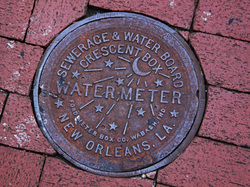
The odors arise from anaerobic conditions where sulfate reducing bacteria (SRB) become a substantial portion of the biomass. These organisms produce the H2S. Other microbes in the same anaerobic conditions also produce the equally odorous organic acids and mercaptans. The key is sewer lines have anaerobic environments with excess BOD (microbial food) and the only available electron acceptor is sulfate (SO4) or other organic compounds.
I will cover the currently used control methods and then propose an option that can reduce chemical demand and odor complaints. Typical odor control approaches rely on the following
- Ferric Chloride & H2S binding agents
- Hypochlorite & Hydrogen peroxide
- Sodium hydroxide - makes H2S more soluble in water & lowers volatile organic acids
- Nitrate Solutions
- Perfumes
- Biocides
- Enzymes & Microbial additives
Over the past 15 years, I have worked on a multiple part approach that actually alters the anaerobic zones to prevent the formation of H2S & organic acids before they cause odor problems. This approach is much less costly than adding chemicals after the problem is present and more effective in the long run. Such a program is based on the biochemistry in the sewer microbes and uses simple monitoring/operational protocols.
The problem anaerobic zones must be identified and readings for H2S, pH, and redox potential (mV) must be taken. You are looking for drops in pH and more negative redox readings which indicate future production of odors. When you have a pH below 7 with a redox below -150 mV, the conditions begin to favor SRB and fermentative microbes that are the source of the odors. What we then do is use enough nitrate solution to increase the redox potential to disfavor the problematic microbes. The dose is not based on stoichiometric oxidation of H2S, instead we are looking just to move the redox potential to prevent the production of H2S.
We have also found that we can help improve nitrate effectiveness by adding microbes that can utilize nitrate to oxidize any H2S and organic acids present in the water. These microbes make enzymes that readily liberate the oxygen bound to the nitrate for use in degrading organics. This process ensures that all nitrate is consumed and converted into harmless nitrogen gas before entering the wastewater treatment plant.
This whole process can be utilized by any municipality and will allow for better control of odors by understanding the collection system biochemistry. If you have any questions on the process or are interested in using the technology with your utility feel free to contact me at [email protected].

 RSS Feed
RSS Feed